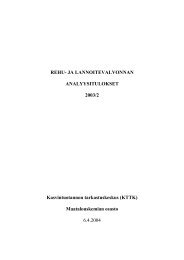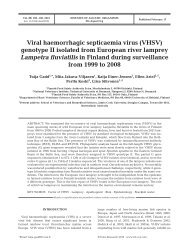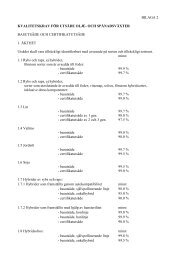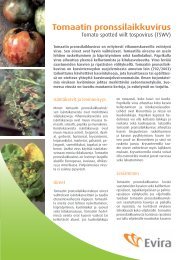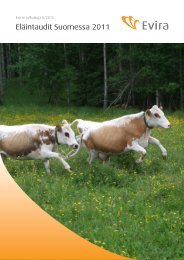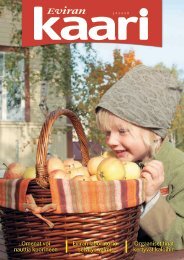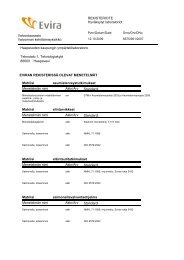Genetic characteristics of field and attenuated rabies viruses ... - Evira
Genetic characteristics of field and attenuated rabies viruses ... - Evira
Genetic characteristics of field and attenuated rabies viruses ... - Evira
You also want an ePaper? Increase the reach of your titles
YUMPU automatically turns print PDFs into web optimized ePapers that Google loves.
virus isolates were studied with a mAb P-41 (Selimov et al. 1983, 1994). Gribencha et al.<br />
(1989) developed a panel <strong>of</strong> 7 anti-nucleocapsid <strong>and</strong> 3 anti-glycoprotein mAbs, <strong>and</strong> these<br />
have demonstrated that individual variants <strong>of</strong> the <strong>rabies</strong> virus can be detected using this<br />
panel. Botvinkin et al. (1990) applied a panel <strong>of</strong> 39 mAbs to characterize 98 <strong>rabies</strong><br />
<strong>viruses</strong>, which resulted in several diverse reaction patterns indicating that different<br />
antigen variants were found during those studies. In 1991, Gribencha et al. have<br />
published research studies aimed at obtaining a panel <strong>of</strong> mAbs to characterize<br />
antigenically the vaccine strain Vnukovo-32 <strong>and</strong> to compare its antigenic properties with<br />
the <strong>field</strong> <strong>rabies</strong> <strong>viruses</strong> (Gribencha et al., 1991a, b). Botvinkin et al. (2006) applied a wide<br />
panel <strong>of</strong> 74 mAbs <strong>and</strong> compared the results obtained with phylogenetic data, where it<br />
was demonstrated that the results <strong>of</strong> the antigenic studies are <strong>of</strong>ten in concordance to<br />
those <strong>of</strong> genetic studies.<br />
1.7.2. <strong>Genetic</strong> characterization <strong>of</strong> <strong>rabies</strong> virus<br />
According to the WHO Expert Consultation on Rabies (2005) it is important to<br />
conduct molecular characterization <strong>of</strong> the new <strong>field</strong> isolates <strong>of</strong> the <strong>rabies</strong> virus. Several<br />
phylogenetic <strong>and</strong> molecular-epidemiological studies on <strong>rabies</strong> have been performed<br />
during the past 10 years (Smith et al., 1992; Kissi et al., 1995; Bourhy et al., 1999, Nadin-<br />
Davis et al., 1999; Holmes et al., 2002; Kuzmin et al., 2004, Real et al., 2005). These<br />
studies have shown that the <strong>rabies</strong> <strong>viruses</strong> can be divided into two major groups, one<br />
comprising <strong>viruses</strong> isolated from terrestrial mammals <strong>and</strong> the other containing <strong>viruses</strong><br />
isolated from bats or spillover infections from bats.<br />
Additionally, there is a viral lineage that is closely related to the bat <strong>rabies</strong> virus but<br />
which circulates independently in raccoons <strong>and</strong> skunks, suggesting that it might<br />
represent a secondary transmission from bats. It was also found that among terrestrial<br />
mammals, <strong>rabies</strong> <strong>viruses</strong> cluster more by geographical origin than by host species, <strong>and</strong> in<br />
this case, closely related <strong>viruses</strong> infect a variety <strong>of</strong> species (Davis et al., 2006). The<br />
phylogenetic reconstruction strongly supports the hypothesis that host switching has<br />
occurred in the history <strong>of</strong> the Lyssa<strong>viruses</strong>. It has been proven that the Lyssa<strong>viruses</strong><br />
have evolved in chiropters long before the emergence <strong>of</strong> the carnivoran <strong>rabies</strong>, probably<br />
due to spillovers from bats (Badrane <strong>and</strong> Tordo, 2001). The <strong>rabies</strong> virus is an ancient<br />
virus but it has been suggested that the current diversities in the genotype 1 <strong>of</strong> the<br />
Lyssa<strong>viruses</strong> from diverse geographical locations <strong>and</strong> different species may have started<br />
only within the last 500 years (Holmes et al., 2002).<br />
31



